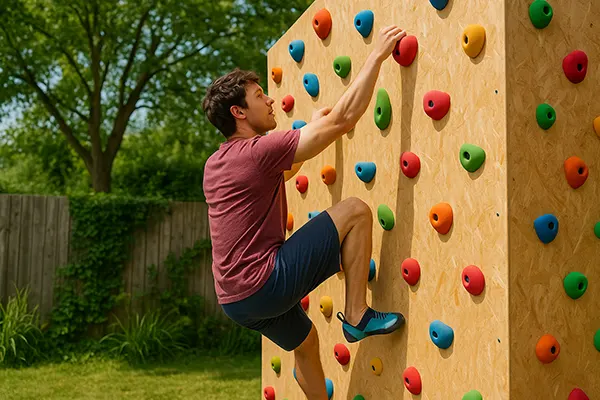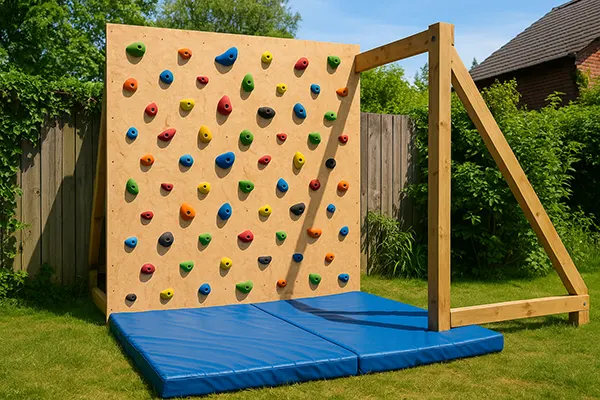Home Bouldering for Beginners: How to Set Up a Safe Wall or Fence Zone
Bouldering is gaining popularity as an accessible and cost-effective way to stay active, challenge the body, and enjoy a sense of adventure without leaving home. Unlike traditional climbing, it doesn’t require a tall wall or elaborate equipment — just creativity, basic materials, and a clear understanding of safety principles. Whether you live in a countryside home or a suburban backyard, home bouldering is a real possibility in 2025.
Essential Materials for a DIY Bouldering Wall
Setting up a basic bouldering zone begins with selecting proper materials that ensure both safety and durability. The most affordable and practical choice remains plywood — specifically 18–21mm thick birch plywood, as it holds screws well and withstands repeated stress. A single wall section of 2×2 metres can accommodate multiple routes if equipped thoughtfully.
Next, climbing holds must be attached using T-nuts and bolts. As of June 2025, sets of holds (30–50 pieces) are available from European manufacturers like Axis, Flathold, or Rockcity for under €150. Don’t forget that high-density crash mats (minimum 10–15cm thick) are critical and should be laid under the entire climbing area — even for low-height structures.
Mounting options include garden fences, garage walls, or independent wooden frames. Reinforce structures to carry dynamic weight — not just static load. Professionals advise anchoring frames into ground or concrete footings to avoid shift or collapse.
Basic Tools and Setup Considerations
To complete your setup, you’ll need a drill, spanner, spirit level, saw, measuring tape, and safety goggles. Most work can be done solo, but wall mounting should be double-checked by another person to ensure alignment and bolt security. T-nuts should be pre-installed in a grid pattern (minimum 20–25 per m²) to allow route flexibility.
Modern home setups often include angled panels — a 15–30° overhang increases difficulty without extending height. It’s important to finish the wall with sanded edges and apply protective varnish or exterior paint to avoid moisture damage, especially if the structure is outdoors.
In case of outdoor installations, select weather-resistant screws and galvanised fittings. Fence-mounted panels must also account for vibrations and impacts — use vibration-dampening washers if needed.
Understanding Routes and Ensuring Safety
Even at home, safety in bouldering cannot be taken lightly. A fall from even 1–2 metres can result in serious injury if mats or landings aren’t optimally positioned. Always position mats to overlap, and never climb higher than your crash mat setup can support. Children should be supervised at all times.
Bouldering routes, or “problems”, can be created by arranging holds in a specific order. Beginners can start with four-point routes (two hands, two feet) using colour-coded holds. Avoid placing small crimps or slopers near the ground where falls are more likely.
Climbers should warm up before use and avoid climbing alone in isolated areas. When possible, use a spotter — a person who directs falls to the mat safely. Helmet use is not standard in bouldering but can be considered for children or uneven garden surfaces.
Types of Routes for Skill Progression
Three general route types can help develop a climber’s ability: vertical (easy to grip, less overhang), slab (requires balance and technique), and overhangs (focus on strength and dynamic movement). At home, you can mix these by adjusting wall angles or hold orientation.
A vertical section can support endurance-focused climbing, allowing long sequences. A slight overhang (15–25°) introduces body tension and core strength training. Use large jug holds initially, then experiment with pinches and edges as skills grow.
Route difficulty can also be adjusted by limiting footholds or allowing only certain coloured holds. Try to build routes with variety and encourage creativity in solving problems, not just strength-based climbing.

Training Exercises to Improve Balance and Strength
Regular climbing is the best training for climbing — but supplementary exercises help. Balance and coordination can be trained on a simple slackline or balance board, especially useful when you can’t climb daily. These tools are affordable and fit in most garden or home spaces.
Strength-focused workouts should include pull-ups, leg raises, and core stability drills. For climbers, fingerboard training (for grip and contact strength) is also useful but should only be used after 3–6 months of basic climbing to avoid injury.
Incorporate antagonistic training — that is, exercises that strengthen muscles not used during climbing (e.g. push-ups, shoulder mobility). This reduces risk of overuse injuries and improves overall athleticism.
Structuring a Weekly Climbing Routine
A basic week plan for beginners might include 2–3 climbing sessions, 1 session of balance training, and 2 short strength workouts (20–30 minutes). Always allow for recovery days, especially after intense sessions or outdoor bouldering.
Focus sessions on technique, not just repetition. Try to complete routes with fewer attempts, analyse mistakes, and vary your movement style. If space allows, install a mirror nearby to evaluate posture and movement flow.
Keeping a climbing logbook — either paper or app-based — helps track progress. Note route types, difficulty, number of attempts, and perceived effort. Over time, this helps tailor training and measure improvement objectively.





